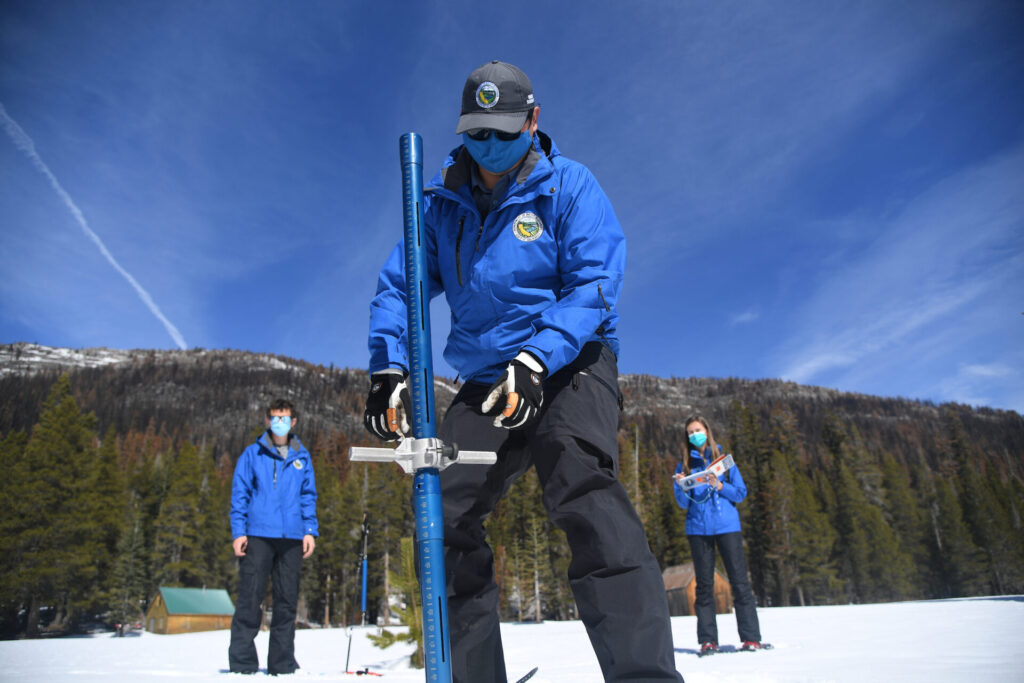California’s Department of Water Resources (DWR) conducted its third snow survey of the season and the outlook is not good for the state’s water users.
The survey recorded 35 inches of snow at Phillips Station in the Sierra Nevada mountains below Lake Tahoe. That’s about 68% of average for this time of year. Statewide, snowpack is 63% of average. The measurements come after the driest January and February in California’s recorded history.
“With only one month left in California’s wet season and no major storms in the forecast, Californians should plan for a third year of drought conditions,” said Karla Nemeth, director of DWR, in a press release. “A significantly below-average snowpack combined with already low reservoir levels make it critical that all Californians step up and conserve water every day to help the state meet the challenges of severe drought.”
The early season fall storms that soaked the state weren’t drought busters and with a bone-dry winter, state officials are telling Californians to brace for a third year of severe drought.
The State Water Project, operated by DWR, put water contractors on notice in late January that they should expect only a 15% allocation this year. It remains to be seen if that number holds. In 2021, DWR had initially announced it would deliver a 10% allocation, but had to drop that amount in the spring to 5% as anticipated snowpack was mostly sucked up by the intensely dry forest floor.
In light of this year’s continued dry conditions, Governor Newsom has asked all Californians to cut their water use by 15% compared to 2020 levels.
“Our latest statewide snowmelt forecasts are only 66 percent of average,” said Sean de Guzman, manager of DWR’s Snow Surveys and Water Supply Forecasting Unit, in the press release. “That is not enough to fill up our reservoirs. Without any significant storms on the horizon, it’s safe to say we’ll end this year dry and extend this drought a third year.”
That won’t be good for residents in many areas of rural San Joaquin Valley where groundwater levels dropped significantly last year as farmers, cut off from surface supplies, turned to pumping to keep crops alive.
“Last summer, residents were regularly calling to let us know their wells were on the verge of or already dry — leaving families with no running water in their homes,” wrote Daisy Gonzalez, community solutions coordinator for nonprofit Community Water Center, in an email. “We knew if the drought continued this year we would continue to face devastating impacts in our communities. This summer, it won’t be a surprise when wells start running dry, so it’s crucial that we have the resources in place to connect homes directly to bottled water and dry well services.”
The state’s March snow survey comes almost a week after the federal Bureau of Reclamation announced that most irrigators in the San Joaquin Valley would be getting little to no surface water in 2022 from the Central Valley Project, a more than 400-mile network of federal canals and dams that transport water to farms and towns throughout the valley.
Share this:
- Click to share on Facebook (Opens in new window)
- Click to share on Twitter (Opens in new window)
- Click to share on LinkedIn (Opens in new window)
- Click to share on Reddit (Opens in new window)
- Click to share on Tumblr (Opens in new window)
- Click to share on Pinterest (Opens in new window)
- Click to share on Pocket (Opens in new window)
- Click to share on Telegram (Opens in new window)
- Click to share on WhatsApp (Opens in new window)
- Click to print (Opens in new window)








